Field Bindweed (Convolvulus arvensis)
Family:
Morningglory Family (Convolvulaceae)
Other Names:
bearbind, bellbine, corn lily, cornbind, creeping Jenny, devil's guts, European bindweed, green-vine, hedge-bells, lap-love, lesser bindweed, liseron, possession vine, sheep-bine, small-flowered morningglory, wild morningglory, withwind.
Origin and Distribution:
Field bindweed is a native of Europe and Asia that has spread throughout the world. It is considered a serious weed in 14 countries and a problem in 19 others, including the U.S. and Canada. The first observation of field bindweed in the U.S. was in 1739 in Virginia, after which its range expanded to include The Great Plain States, and its presence on the West Coast was noted in the mid-1800's. It is currently distributed throughout the United States except for a few southern locations. Field bindweed commonly occurs in two-thirds of the counties in Ohio. It is a weed of cultivated areas including fields, pastures, lawns, and gardens as well as other disturbed sites such as roadsides, fencerows, parking lots, and waste areas. It prefers rich, fertile soils but can also persist on poor, gravelly soils.
Plant Description:
Field bindweed is a twining perennial vine. Characteristics distinguishing it from other vines include arrowhead-shaped leaves, thin stems, pinkish petals fused into funnel-shaped flowers, the presence of small bracts attached to flower stalks about an inch below the base of the flower, a perennial taproot, and invasive rhizomes (horizontal underground stems). The plant reproduces by seeds and regenerates new plants from adventitious buds on roots and rhizomes.
Root System:
Roots are whitish, cord-like, fleshy, and develop into an extensive system comprised of taproots, vertical roots, horizontal roots, and rhizomes (horizontal underground stems). Taproots extend 9 feet or more below the soil surface. Lateral roots are shallow and comprise most of the root mass. Rhizomes grow in all directions occupying an area that may be 18 feet or more in diameter.
Seedlings and Shoots:
Young plants have dull red stems and light green leaves. Leaf stalks (petioles) are flattened, kidney-shaped in cross-sections, and have a groove on the upper side.
Stems:
Stems are viney, slender, hairy or hairless, 9 feet long or longer, and either trailing along the ground or climbing over objects.
Leaves:
Leaves are alternate (1 leaf per node), 1 to 2 inches long, 1 inch wide, arrowhead-shaped, and bluish-green. At the base of each leaf are 2 lobes, one on either side of the petiole, that may be either rounded or pointed outward. The outline of a typical leaf narrows gradually upward such that its sides are nearly parallel. Leaf tips are generally rounded. Leaves attach to stems by way of long petioles.
Flowers:
Flowers are funnel-shaped, white to pinkish, and less than 1 inch across. Flowers form either alone or in groups of 2 to 4 at the end of long stalks arising from the stem at the leaf axils. Attached to stalks about 1 inch below each flower are minute, leaf-like bracts.
Fruits and Seeds:
Fruits are egg-shaped capsules containing 2 to 4 seeds. The blackish-brown seeds are 3-angled with 1 rounded side and 2 flat sides. Their shape is similar to that of a quartered orange.
Similar Species:
Other weedy vines such as hedge bindweed (Calystegia sepium), honeyvine milkweed (Ampelamus albidus), and wild buckwheat (Polygonum convolvulus) can be distinguished from field bindweed by the appearance of the leaves and flowers. Hedge bindweed has larger leaves with squarer lobes and tips that are more pointed than those of field bindweed. Also, hedge bindweed flowers are larger than those of field bindweed and the base of each flower is enclosed by 2 large bracts, which are much smaller and located about an inch below the flower in field bindweed. Honeyvine milkweed leaves are opposite (2 leaves per node) and heart-shaped while field bindweed leaves are alternate (1 leaf per node) and arrowhead-shaped. Field bindweed flowers are funnel shaped, pinkish, and much larger than those of either honeyvine milkweed, which are vase-shaped and clustered, or wild buckwheat, which are greenish and inconspicuous. In addition, wild buckwheat is an annual lacking perennial creeping roots. Flowers of annual and perennial morningglory species (Ipomoea spp.), including bigroot morningglory (Ipomoea pandurata), are shaped similarly to those of field bindweed but their leaves are heart-shaped rather than arrowhead-shaped.
Biology:
Flowering generally begins in June and continues until frost. A single plant may produce 25 to 550 seeds. If buried in soil, seeds can remain viable and germinate sporadically for over 20 years. Seeds develop a hard coat making them impervious to water and capable of surviving ensiling, digestion, fumigation with methyl bromide, and other deleterious conditions. As a consequence of their extensive root system, field bindweed plants are usually able to withstand long periods of stressful conditions including drought. A single plant may spread more that 9 feet in diameter in a single growing season in addition to sending out rhizomes that if separated can form independent plants. Longevity of seeds in soil along with this system of roots and rhizomes make field bindweed a noxious weed that is difficult to control. Tillage and cultivation severe roots and rhizomes forming fragments that can produce new plants. To optimize control, a combination of management practices such as cultivation, herbicide application, and crop rotation is recommended.
Toxicity:
There are no references indicating that the plant is poisonous to humans. However, seeds are suspected of containing toxic and hallucinogenic substances. Roots may be slightly poisonous to swine, although they frequently eat the weed and are usually not affected.
Facts and Folklore:
'Convolvo' is Latin meaning 'to entwine'; 'arvens' is Latin for 'of cultivated field'.
By the 1920's, many states proclaimed field bindweed a serious weed, especially states west of the Mississippi including California, Colorado, Kansas, Nebraska, Iowa, Minnesota, North and South Dakota, Idaho, Utah, Washington, and Texas.
Stems always twine around objects in a counter-clockwise direction.
Field bindweed flowers persist for a single day.
Field bindweed serves as an alternate host for several vegetable viruses.
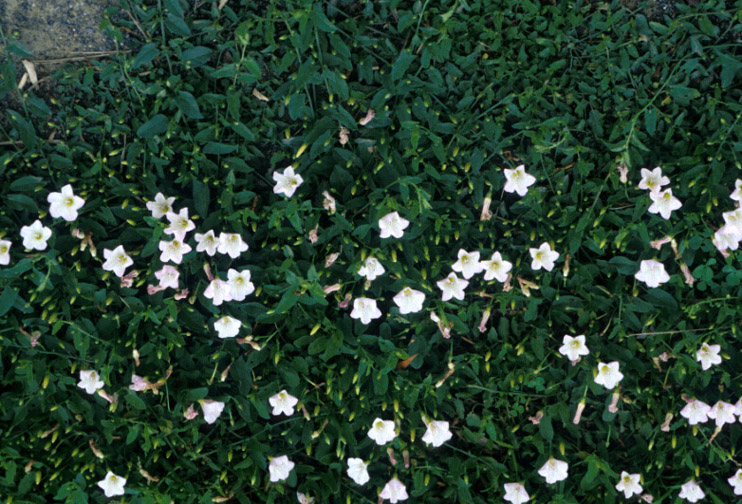
Field bindweed seedling.

Field bindweed stem and leaves; note rounded tip, pointed rather than square lobes.
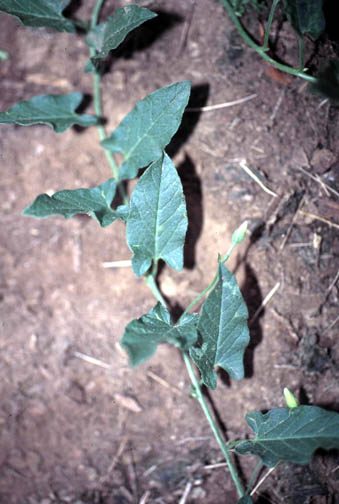
Underside of field bindweed leaves.

Field bindweed seeds.
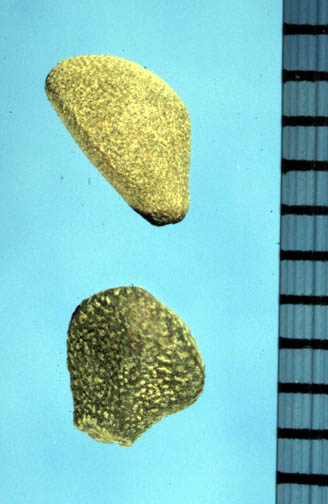
Comparison of first leaves of field bindweed (top) and hedge bindweed (bottom).
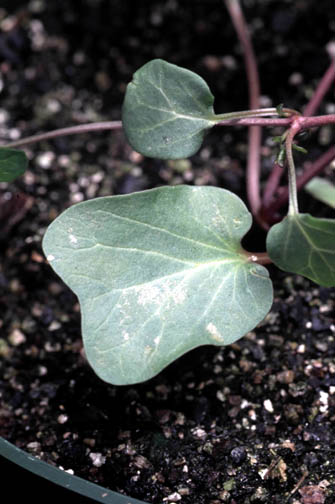
Comparison of field bindweed (bottom) and hedge bindweed (top) leaves.

Field bindweed flower; note small leafy bract about an inch down the stem.
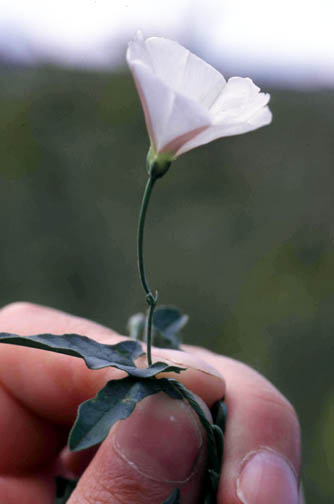
Field bindweed flower; color varies from white to pink.
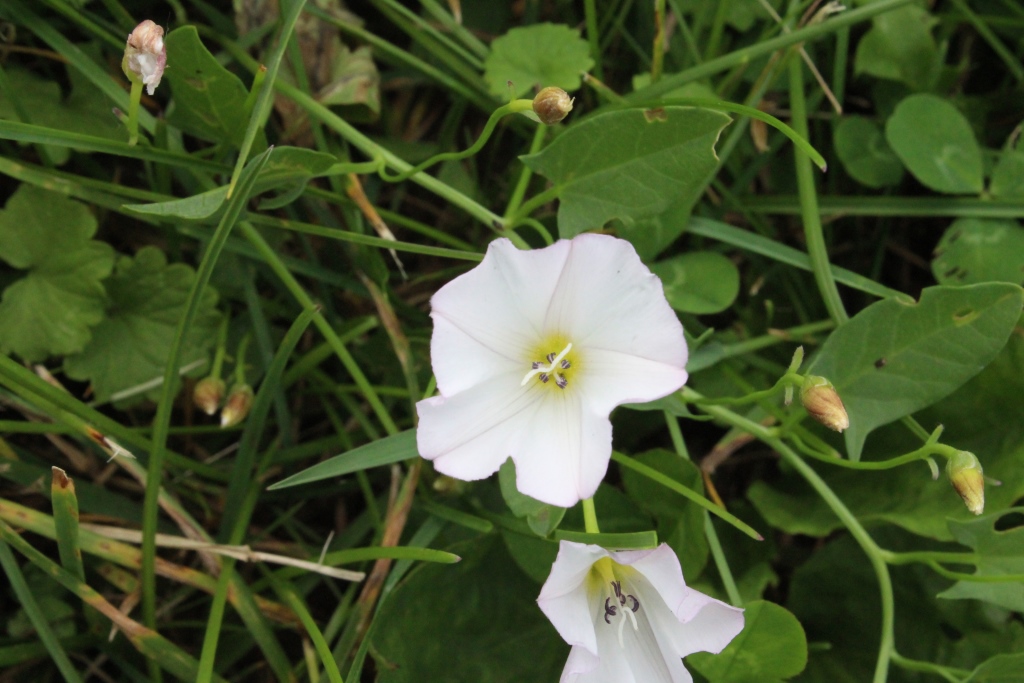
Field bindweed in a yard
